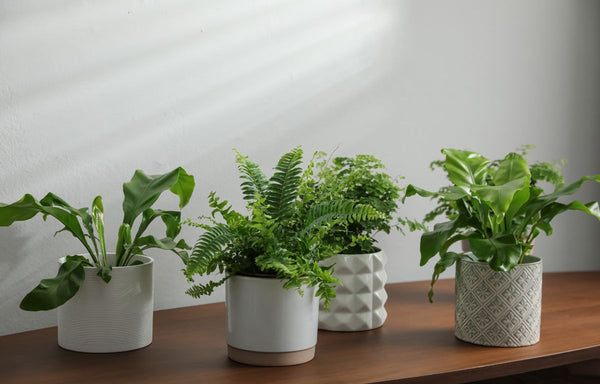Citrus trees are a delightful addition to any garden or even a potted plant collection. Known for their lush green foliage, fragrant flowers, and, of course, the delicious fruits they produce, these trees thrive in extremely sunny and warm...
Citrus trees are a delightful addition to any garden or even a potted plant collection. Known for their lush green foliage, fragrant flowers, and, of course, the delicious fruits they produce, these trees thrive in extremely sunny and warm conditions. With the right care and attention, you can add a bounty of fresh, homegrown citrus to your beverages and dishes this summer.

Types of Citrus Trees
Before delving into summer care, it's important to understand the different types of citrus trees you can grow. Among the most popular are:
Dwarf Citrus Trees: These compact trees are perfect for small gardens, patios, or even indoor cultivation.
Dwarf Meyer Lemon (Citrus x meyeri): This small tree produces sweet, juicy lemons perfect for cooking and beverages. It thrives in containers and can be grown indoors. Dwarf Key Lime (Citrus aurantiifolia): Ideal for adding zest to your dishes, the Dwarf Key Lime is compact and can be grown both indoors and outdoors in containers. Dwarf Calamondin (Citrus microcarpa): Known for its ornamental appeal, the Dwarf Calamondin produces small, tart oranges. It's excellent for container gardening and can be used for jams and garnishes.Standard Citrus Trees: These trees grow larger and produce more fruit but are not suitable for small spaces.
Eureka Lemon (Citrus limon 'Eureka'): Eureka lemon trees are known for their juicy, tart lemons. They are a popular choice for home gardeners and produce fruit throughout the year. Valencia Orange (Citrus sinensis 'Valencia'): Valencia orange trees are famous for their sweet and juicy oranges, perfect for fresh eating or juicing. They are a prolific fruit producer. Lime (Citrus aurantiifolia or Citrus latifolia): Lime trees produce small, green, and highly acidic fruits used in cooking, beverages, and garnishing dishes.Flowers To Fruit
Citrus trees begin fruit production when flowers are pollinated, leading to fertilisation, the development of the ovary into fruit, maturation, and eventual harvest, with some varieties being seedless. The number of flowers a tree produces can vary depending on its age, health, and environmental conditions. Citrus trees typically produce flowers in the spring. These flowers are usually white or pale in colour and have a sweet fragrance. Most citrus trees are self-pollinating to some extent, which means that they can set fruit with their own pollen. However, cross-pollination by insects, particularly bees, can enhance fruit production and quality. Some citrus trees, like certain types of mandarins and kumquats, can start producing fruit as early as 2 to 3 years after planting, while others, like grapefruits and oranges, may take 3 to 6 years or more.
Citrus Tree Care
Sunlight:
Citrus trees love sunlight and require high exposure for photosynthesis and overall health and growth. The healthier the citrus Tree, the more abundant and flavourful fruit it will produce. During the summer, ensure your citrus tree receives at least 8-12 hours of direct sunlight daily. If you're growing them indoors, place your citrus tree near a sunny window or use grow lights to increase exposure.Watering:
Citrus trees prefer consistently moist but well-draining soil. Water deeply and less frequently rather than shallow and frequent watering. In the summer, increase watering to keep the soil consistently moist, especially during hot spells. Always check the topsoil to ensure that you are not over or underwatering. Outdoor trees may benefit from a drip irrigation system that retains soil moisture with little maintenance.Fertilising:
Citrus trees require fertilising to ensure they have an adequate supply of essential nutrients, such as nitrogen, phosphorus, and potassium. These nutrients support robust growth, abundant fruit production, and overall tree health. Fertilising also helps maintain proper pH levels in the soil and guards against nutrient deficiencies, ultimately leading to more vibrant foliage and tastier, more bountiful citrus fruits. Feed your citrus trees with a balanced, slow-release fertiliser designed for citrus plants. Apply fertiliser in the early spring and again in late spring or early summer. Avoid over-fertilisation, which can harm the tree.Pruning:
Citrus trees require pruning for several reasons, primarily to remove dead or diseased branches, improve air circulation within the canopy, and shape the tree for better light penetration. Pruning also encourages new growth, reduces the risk of pest infestations, and helps maintain an overall manageable size, making it easier to care for, harvest fruit, and ensure the tree's long-term health and productivity. Summer is a good time for light pruning but avoid it if the weather forecast predicts extreme temperatures as this can add additional stress to your citrus tree.Mulching:
Mulching your citrus tree helps conserve soil moisture, regulate soil temperature, and suppress weed growth around the tree's base. This creates a more stable and favourable environment for the tree's roots, reducing water stress during hot summer months and minimising competition from weeds. Apply a layer of organic mulch around the base of the tree. The layer should be around 2-5cm for indoor or sheltered citrus trees, and around 10cm for outdoor and exposed trees. Make sure that the mulch is not too densely packed as this will prevent water from seeping through and into the soil. You can use bark, wood chips, straw, or plant matter (eucalyptus leaves are great because they are slow to decompose. Alternatively, light-coloured crushed rocks and Sphagnum moss are suitable for a more visually appealing aesthetic.Propagation
Seeds: Seeds from ripe citrus fruit can be saved and stored for planting in well-draining seedling-suitable soil around early summer. The resulting baby trees will have varying adaptions and characteristics as found in nature, and may not take on the features of the parent plant. Cuttings: Take approximately 15cm cuttings from a healthy tree, dip the cut ends in rooting hormone, and plant the dipped ends into well-draining propagating soil. Keep in a humid and sunny environment until roots develop. Air Layering: Encourage roots to grow on a branch by removing a section of bark, applying rooting hormone, and covering it with damp sphagnum moss or plastic wrap. Grafting: Join a desired citrus variety (scion) to a rootstock by matching cambium layers and securing them together. This method ensures the new tree inherits the characteristics of the scion but is better left to more experienced gardeners.
Potential Problems and Solutions
Pests And Disease:
Common citrus pests include aphids, scale insects, and citrus leaf miners. Monitor your trees regularly and use soap solution or neem oil to treat infestations. Encourage natural predators like ladybugs and lacewings. There are also several different types of fruit flies, large bug and ant catchers and traps that are easy to install, preventing them from laying eggs and eating the foliage, flowers, and fruit. Birds are another common problem and are known to peck at or consume citrus fruit. To protect your citrus crop from bird damage, you can use bird netting, scare devices, or reflective tape to deter them from approaching the trees. Citrus trees can be susceptible to fungal diseases such as citrus canker and citrus greening. Prune infected branches and avoid overhead watering. Use copper-based fungicides as a preventive measure.Yellowing Leaves:
Yellowing leaves can be a sign of nutrient deficiency or overwatering. Adjust your fertilisation and watering practices accordingly. Ensure proper drainage by regularly checking the topsoil.Heat Stress:
Hot weather can lead to several issues for citrus trees, including heat and water stress, sunburn on fruit and leaves, increased pest activity, and even diseases like Citrus Scorch Virus. Maintaining proper irrigation, providing shade for young trees, and monitoring for pests and diseases are essential for maintaining your citrus trees. They may also drop immature fruit during hot weather as a natural response to conserve energy and resources. However, excessive fruit dropping can also result from poor pollination, stress, or nutrient imbalances requiring higher doses or a change of fertiliser.Growing and caring for citrus trees can be a rewarding experience. With proper sunlight, watering, fertilisation, and attention to potential problems, you can enjoy a harvest of fresh, fragrant fruit throughout the summer and beyond. So, whether you have a small garden or a sunny windowsill, consider adding a citrus tree to your collection and savour the sweet taste of success.
Keen to read more? Check out our blog on bees and pollination here.














